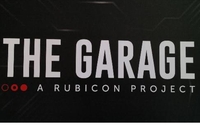Got A Supply Or Demand Idea? Rubicon Has A Garage For You To Build It In
- by Joe Mandese @mp_joemandese, April 15, 2015
 Some of ad technology’s biggest players
started in a garage. Now one of the sector’s biggest is flipping the model and launching a “garage.” In an effort to accelerate innovation and growth for new players to enter the
audience exchange marketplace, publicly-traded Rubicon Project today will unveil its latest project, aptly named The Garage. The unit, which has been secretly in development for months, is basically a
research and development arm designed to kickstart innovative new solutions for players on all sides of the audience supply chain. Not surprisingly, its first two initiatives service the demand- and
supply-sides respectively, and are designed to enable new entrants to come to market.
Some of ad technology’s biggest players
started in a garage. Now one of the sector’s biggest is flipping the model and launching a “garage.” In an effort to accelerate innovation and growth for new players to enter the
audience exchange marketplace, publicly-traded Rubicon Project today will unveil its latest project, aptly named The Garage. The unit, which has been secretly in development for months, is basically a
research and development arm designed to kickstart innovative new solutions for players on all sides of the audience supply chain. Not surprisingly, its first two initiatives service the demand- and
supply-sides respectively, and are designed to enable new entrants to come to market.
“Our goal is to reimagine what advertising is and help create things that redefine the relationship between advertisers and consumers,” Rubicon Project founder and CEO Frank Addante told Real-Time Daily in a briefing late last week in anticipation of today’s announcement.
Addante, and Rubicon Project Chief Knowledge Officer Tim McQuillen, explained that the focus on The Garage will be more of a skunkworks team to foster innovation and test new ideas that could lead to substantive new platforms for trading audiences through programmatic exchanges.
Today’s announcement will officially invite participants into private beta tests of the first two projects: a self-serve “DSP Builder;” and a high-frequency cloud platform -- dubbed HFC2 -- that will essentially enable the same for the supply-side.
Even though some industry observers and analysts have classified Rubicon Project as an SSP, or a supply-side platform, Addante said Rubicon was conceived and continues to develop as a completely neutral player whose only goal is to create liquidity on both sides by reducing friction that unlocks more inventory and market-based trading. To the extent that either side utilizes Rubicon Project’s technology, the company profits by increasing its share of an ever-expanding marketplace of programmatic transactions.
Addante and McQuillen said the new Garage projects are consistent with that theme.
DSP Builder will enable literally anyone to build their own DSP simply by registering an account, and utilizing Rubicon’s templates and bidding engine technology. Addante said users can customize their DSP anyway they want, whether it is simply reskinning its look, carving out unique audience segments or ways of defining their market. Garage’s goal, he said, is simply to enable them to leverage their own creativity to foster new markets and new market makers.
He says this is consistent with Rubicon Project’s roots and while he doesn’t attribute the industry’s growth exclusively to the company’s innovations, he points out that the audience marketplace accelerated at least twice when Rubicon Project enabled new tools. In 2007, when Rubicon Project introduced an ad network optimization platform, the number of ad networks accelerated from 100 to more than 500. In 2010, when Rubicon Project introduced its real-time bidding platform, the number of DSPs in the market went from zero to more than 300.
By enabling an easy-to-use, self-serve development platform to create new real-time bidding applications, Addante said DSP Builder could expand the number of demand-side players dramatically, enabling any entrepreneur or developer build their own customized bidding solution in “minutes.”
One of the graphics in The Garage’s pitch deck characterizes the opportunity this way: “Be a rock star! Build a better bidder faster and cheaper!”
While HFC2 isn’t exactly the same self-serve model for SSPs, it will enable any transactions-based player to leverage the cloud infrastructure that Rubicon Project had to build our to support its own transactional marketplace capabilities. In effect, it is a similar concept to what Amazon did by leasing and licensing the surplus capacity of its own server cloud to support a rapidly expanding community of website publishers that didn’t need to invest in their own hardware.
The difference, said Addante, is that whereas Amazon’s cloud was build to support websites, The Garage’s HFC2 platform was built to support “transactions.” Conceivably, he said, it could be utilized for any form of electronic transactions, including financial ones, especially things like energy markets, but he said its initial focus will be to support media transactions.
While HFC2 isn’t as self-serve on the applications side as DSP Builder, McQuillen said that an decent developer could utilize it to build applications enabling new supply-side markets on its backbone. While it primarily is an infrastructure play, McQuillen and Addante said Rubicon Project will also provide some managed service applications to help entrepreneurs get off the ground using it in order to facilitate the market.
While both projects are closed betas until they’re ready for a general release, Addante said the team is already developing business rules and models for scaling the business. He said both likely would be software and technology licensing models based on usage and volume.
Addante and McQuillen said they already have ideas for other Garage projects, but they want to test and deploy the first two before priming the market for even more innovation.


